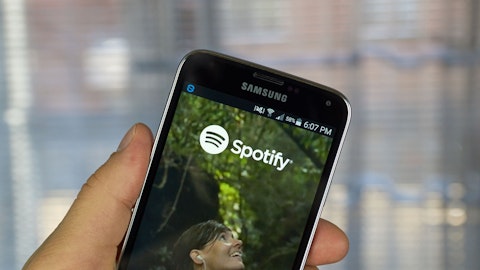Spotify Technology S.A. (NYSE:SPOT) Q1 2024 Earnings Call Transcript April 23, 2024
Spotify Technology S.A. isn’t one of the 30 most popular stocks among hedge funds at the end of the third quarter (see the details here).
Operator: Thank you for standing by. My name is Krista and I’ll be your conference operator today. At this time, I would like to welcome everyone to the Spotify First Quarter 2024 Earnings Conference Call. All lines have been placed on mute to prevent any background noise. After the speakers’ remarks, there’ll be a question-and-answer session. [Operator Instructions] Thank you. I would now like to turn the conference over to Bryan Goldberg, Head of Investor Relations at Spotify. Bryan, you may begin.
Bryan Goldberg : Thanks, operator, and welcome to Spotify’s First Quarter 2024 Earnings Conference Call. Joining us today will be Daniel Ek, our CEO and Ben Kung, our Interim CFO and VP of Financial Planning and Analysis. We’ll start with opening comments from Daniel and Ben, and afterwards we’ll be happy to answer your questions. Questions can be submitted by going to slido.com, S-L-I-D-O.com, and using the code #SpotifyEarningsQ124. Analysts can ask questions directly into Slido, and all participants can then vote on the questions they find the most relevant. If for some reason you don’t have access to Slido, you can email Investor Relations at ir@spotify.com and we’ll add in your question. Before we begin, let me quickly cover the Safe Harbor.

During this call, we’ll be making certain forward-looking statements, including projections or estimates about the future performance of the company. These statements are based on current expectations and assumptions that are subject to risks and uncertainties. Actual results could materially differ because of factors discussed on today’s call in our shareholder deck and in filings with the Securities and Exchange Commission. During this call, we’ll also refer to certain non-IFRS financial measures. Reconciliations between our IFRS and non-IFRS financial measures can be found in our shareholder deck, in the financial section of our Investor Relations website, and also furnished today on Form 6-K. And with that, I’ll turn it over to Daniel.
Daniel Ek : All right. Thanks, Bryan. And hey, everyone, and thanks for joining us. I hope you’ve had the opportunity to review our shareholder deck. Overall this was a solid quarter driven by strong revenue growth, expanding gross margin and the largest operating income we’ve ever posted. Our performance speaks to what I covered last quarter when I described our outlook for 2024, a year of solid progress with monetization and resourcefulness taking center stage. But Let’s discuss our MAU growth this quarter. We missed our target due to a bit of a slowdown at the start of the year. So I want to directly address the three main factors contributing to this outcome and how we’re adjusting over the next few quarters. First, the MAU and subscription growth we achieved in 2023 not only surpassed our most ambitious forecast, but also set a record for the most significant user growth in Spotify’s history.
While we anticipate continuous robust growth going forward, 2023 was a truly standout year and should not be a based on expectation for every subsequent year. Another significant challenge was the impact of our December workforce reduction. Although there’s no question that it was the right strategic decision, it did disrupt our day-to-day operations more than we anticipate. It took us some time to find our footing, but more than four months into this transition, I think we’re back on track. I expect to continue improving on our execution throughout the year, getting us to an even better place than we’ve ever been. The third issue is related to marketing spend. In hindsight, we probably pulled back too significantly throughout 2023 and as such we’re already correcting this as we move into Q2.
See also 15 Best Cruise Lines in the US and 15 Problems with Over 55 Communities.
Q&A Session
Follow Spotify Technology S.a. (NYSE:SPOT)
Follow Spotify Technology S.a. (NYSE:SPOT)
To be clear, we’re not going to go back to what we were doing before, we still continue to expect improving profitability over the course of this year and into the next. And in new funds are being directed towards acquiring and reactivating high-value users to enhance our base with their deeper engagement and loyalty. We expect to see good improvements in the second half of this year and are confident in our ability to deliver top-of-the-funnel growth at consistently high levels, maintaining our proven track record. So how do we expect this to impact our business in the coming months? Well at Spotify, we don’t rely on a single growth strategy, but rather adjust our focus based on what the business demands. For instance, two years ago we really concentrated on our user growth.
Then last year we restructured our costs and now we’re focused on accelerating revenue while improving our bottom-line. Next year, our focus may return to top-of-the-funnel user growth, but in the near-term, monetization remains our top priority. Bottom-line, we are really good at pivoting our attention when it makes sense. When I say pivot, I really mean making tweaks that will get us to an even better outcome. And because of our ability to do this, I have no doubt that we will be able to recapture top-of-the-funnel growth over time as it becomes more of a focus area for the team. And before I turn it over to Ben to provide more detail into the numbers, I also want to mention our new CFO, Christian Luiga. I’ve worked with Christian directly and I can tell you first hand that he’s a terrific leader and excels at driving both operational efficiency and growth.
He has an impressive track record and his expertise will be incredibly valuable, as we continue on this path. I look forward to you getting to know him when he joins later this year. But I also want to extend a huge thank you to Ben for stepping into the role of Interim CFO and helping to ensure a smooth transition.
Ben Kung : Thanks, Daniel, and thanks everyone for joining us. I’d like to add a bit more color on the quarter and then touch upon the broader performance of the business and our outlook. Q1 marked a strong start to the year, led by accelerating revenue growth and record-setting profitability as our focus on monetization and efficiency have begun flowing through our financials. Although MAU variability was greater than expected, our funnel continued to expand at a reasonably healthy rate within the context of the last few years as total MAU grew 19% year-on-year in Q1 coming off of 2023’s record performance, while quarter-on-quarter net additions of 13 million were in-line with 2021 and 2022 levels. On a subscription front, the business grew in-line with our guidance, adding 3 million net new subscribers.
Total revenue grew 21% year-on-year on a constant currency basis to EUR3.6 billion representing 100 basis points of growth improvement relative to Q4. Notably, our recent price increases and improving product mix shift accelerated premium ARPU growth to 7% year-on-year on a currency neutral basis, while our advertising business saw improved currency neutral growth of 19% year-on-year versus Q4 17%. Moving to profitability, we are very encouraged by the business’s early stage inflection towards the targets we laid out for you at our 2022 Investor Day. Gross margin came in at a Q1 record of 27.6%, surpassing guidance by 121 basis points and resulting in our first ever EUR1 billion plus gross profit quarter. As you’re well aware, there are many components that can move our gross margin, and Q1’s performance was primarily driven by content cost favorability among other smaller movements.
Operating income of EUR168 million also set a new record, aided by gross profit strength and lower operating expenses. Operating income was impacted by EUR82 million in social charge accruals, which were EUR74 million higher than our forecast, driven by share price appreciation during the quarter. As a reminder, we don’t forecast share price movements in our outlook for the business, since they are outside of our control. Finally, free cash flow was a positive EUR207 million in the quarter. Performance here reflected the expected reversal of some of the timing benefits we saw in Q4. We remain confident that we’ve entered a new chapter in terms of expanding the business’s cash generation potential. Looking ahead to second quarter guidance, we are forecasting 631 million MAU, an increase of 16 million from Q1, and 245 million subscribers, an increase of 6 million over Q1.
We are also forecasting a currency neutral revenue growth rate of over 22% year-on-year, pointing to EUR3.8 billion in total revenue. We also anticipate a gross margin of 28.1% and an operating income of EUR250 million. In terms of our user growth outlook, as Daniel mentioned, we’ve made some adjustments to further optimize our marketing activity and expect improving MAU net add levels over the course of the year. With respect to price increases and subscriber growth in Q2, our data shows that historical price increases have had minimal impacts on growth. However, much like Q3 of last year, we are baking in some modest levels of churn into our Q2 outlook. Additionally, we anticipate another quarter of sequential improvement in ARPU growth on a constant currency basis in Q2, similar to the 200 basis points of improvement we saw from Q4 to Q1.
From a profitability standpoint, we continue to expect a sequential ramp in gross margin through the balance of 2024, as well as improvements in operating income and operating margin. With that, I’ll hand things back to Bryan for Q&A.
A: All right. Thanks, Ben. And again, if you’ve got any questions, please go to slido.com #SpotifyEarningsQ124. We’ll be reading the questions in the order they appear in the queue with respect to how people vote up their preference for questions. And our first question today is going to come from Agnieszka Pustula on music profitability. Can you please give us some detail on the improved music profitability in the quarter? Which marketplace product was the key driver behind better margins and how much of extra cost did audiobooks add?





